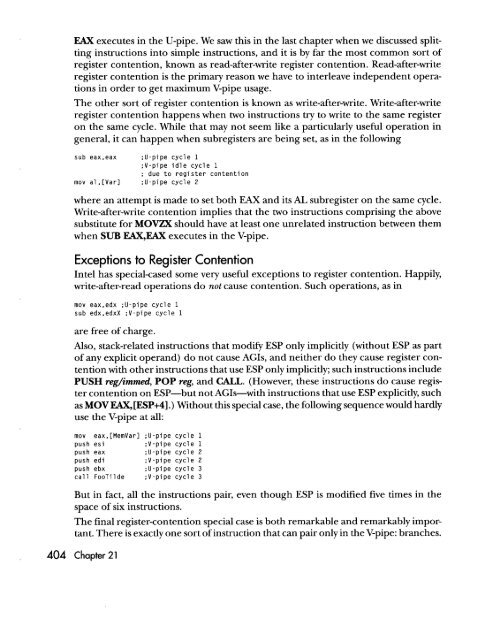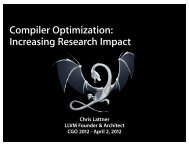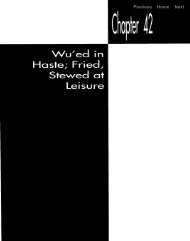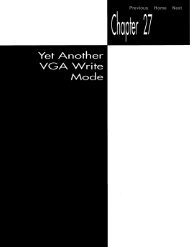unleashing the pentium's V-pipe
unleashing the pentium's V-pipe
unleashing the pentium's V-pipe
You also want an ePaper? Increase the reach of your titles
YUMPU automatically turns print PDFs into web optimized ePapers that Google loves.
EAX executes in <strong>the</strong> U-<strong>pipe</strong>. We saw this in <strong>the</strong> last chapter when we discussed splitting<br />
instructions into simple instructions, and it is by far <strong>the</strong> most common sort of<br />
register contention, known as read-after-write register contention. Read-after-write<br />
register contention is <strong>the</strong> primary reason we have to interleave independent operations<br />
in order to get maximum V-<strong>pipe</strong> usage.<br />
The o<strong>the</strong>r sort of register contention is known as write-after-write. Write-after-write<br />
register contention happens when two instructions try to write to <strong>the</strong> same register<br />
on <strong>the</strong> same cycle. While that may not seem like a particularly useful operation in<br />
general, it can happen when subregisters are being set, as in <strong>the</strong> following<br />
sub eax.eax ;U-<strong>pipe</strong> cycle 1<br />
;V-<strong>pipe</strong> idle cycle 1<br />
; due to register contention<br />
mov al,[Varl ;U-<strong>pipe</strong> cycle 2<br />
where an attempt is made to set both EAX and its AL subregister on <strong>the</strong> same cycle.<br />
Write-after-write contention implies that <strong>the</strong> two instructions comprising <strong>the</strong> above<br />
substitute for MOVZX should have at least one unrelated instruction between <strong>the</strong>m<br />
when SUB EAX,EAX executes in <strong>the</strong> V-<strong>pipe</strong>.<br />
Exceptions to Register Contention<br />
Intel has special-cased some very useful exceptions to register contention. Happily,<br />
write-after-read operations do not cause contention. Such operations, as in<br />
mov eax,edx ;U-<strong>pipe</strong> cycle 1<br />
sub edx.edxX ;V-<strong>pipe</strong> cycle 1<br />
are free of charge.<br />
Also, stack-related instructions that modify ESP only implicitly (without ESP as part<br />
of any explicit operand) do not cause AGIs, and nei<strong>the</strong>r do <strong>the</strong>y cause register contention<br />
with o<strong>the</strong>r instructions that use ESP only implicitly; such instructions include<br />
PUSH reg/immed, POP reg, and CALL. (However, <strong>the</strong>se instructions do cause register<br />
contention on ESP-but not AGIs-with instructions that use ESP explicitly, such<br />
as MOV EAX,[ESP+4].) Without this special case, <strong>the</strong> following sequence would hardly<br />
use <strong>the</strong> V-<strong>pipe</strong> at all:<br />
mov eax,[MemVar] ;U-<strong>pipe</strong> cycle 1<br />
push esi ;V-<strong>pipe</strong> cycle 1<br />
push eax ;U-<strong>pipe</strong> cycle 2<br />
push edi ;V-<strong>pipe</strong> cycle 2<br />
push ebx ;U-<strong>pipe</strong> cycle 3<br />
call FooTilde ;V-<strong>pipe</strong> cycle 3<br />
But in fact, all <strong>the</strong> instructions pair, even though ESP is modified five times in <strong>the</strong><br />
space of six instructions.<br />
The final register-contention special case is both remarkable and remarkably important.<br />
There is exactly one sort of instruction that can pair only in <strong>the</strong> V-<strong>pipe</strong>: branches.<br />
404 Chapter 21
















